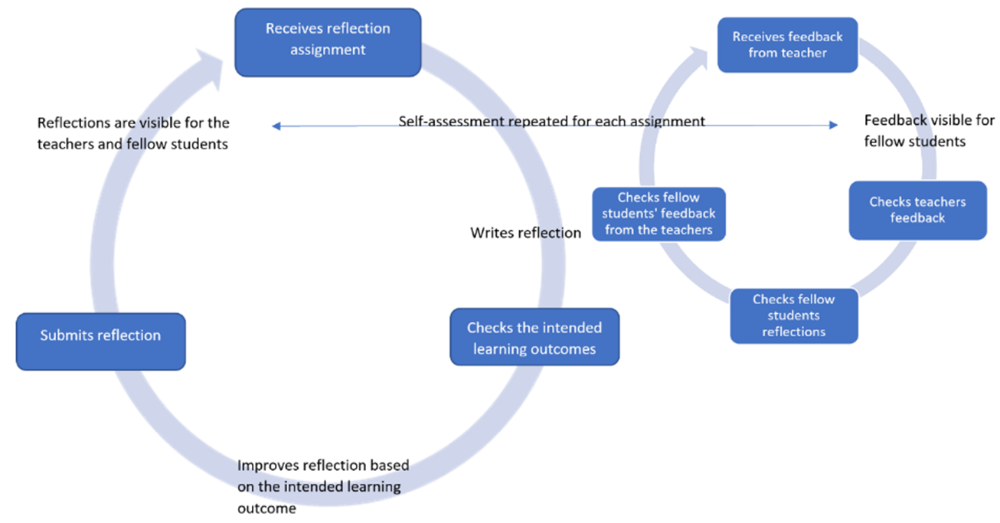E-portfolio
E-Portfolio for Comprehensive Learning and Reflection
Interview with Excited Fellow Hege Annette Olstad
By Guttorm Sindre, April 1, 2022

Department of Computer Science and Informatics
Many students may perceive their studies as fragmented, where each subject builds an isolated island of knowledge that they subsequently abandon and forget once they've passed the exam and move on to the next subject. The Student Barometer also indicates that many students struggle to see the professional relevance of what they are learning. Someone aiming to address this issue, considering digital tools as part of the solution, is Hege Annette Olstad, a PhD Fellow at Excited. She is researching e-portfolios as a tool for formative assessment and support for students' self-reflection.
- But what is the difference between an e-portfolio and traditional portfolio assessment, which many subjects already use?
- An e-portfolio can be used for portfolio assessment within a single subject, says Hege. But the significant point of an e-portfolio is that it can also be used across and throughout subjects, throughout the entire course of study – and that it can be taken into the professional world for job hunting and lifelong learning. Another significant difference is ownership. Today, portfolio assessments often take place in an LMS (Learning Management System) that students lose access to once they graduate. Unlike an LMS, the e-portfolio is owned by the students. Therefore, students have access to what they've worked on even after they've completed their education.
-So, in a way, it's a bit like the portfolios architects or graphic designers have, showcasing drawings, images, and models of things they've created?
- Yes, you could say that; it contains digital evidence of learning, experiences, and achievements. This provides much greater flexibility in its content, making it easier to share with others, such as classmates, instructors for feedback, or potential employers. Different content can be quickly selected based on who it's being shared with.
- What do you envision students typically including in such an e-portfolio?
- It could be almost anything in terms of artifacts: Exam answers and mandatory assignments. Project reports. Video recordings of presentations they've given. Our trials so far have involved IT students, so program code they've written, apps they've developed, could also be typical content - anything that can demonstrate their technical competence and ability to collaborate and communicate. Unlike what ends up in the university's LMS – typically formal responses to assignments – an e-portfolio can also contain results from hobby projects, work for voluntary organizations, insights from part-time jobs, and summer jobs. Thus, it can encompass everything learned during the study period. However, the most essential aspect is not the artifacts themselves but reflecting on these artifacts and what they represent.
By writing reflections on the artifacts during their studies, students become more aware of the kind of expertise they've gained. Consequently, the e-portfolio can become more than just a collection of individual works from various courses; it becomes a larger whole where students develop a more explicit understanding of the connection between learning outcomes from different courses and how these gradually build up into comprehensive competencies that qualify them for future professional roles.
- What kind of practical testing of e-portfolios have you conducted in your research?
- So far, it has been piloted in the subject "Data-Supported Collaboration" at NTNU. Here, the e-portfolio was used to support a process of individual reflection around submitted assignments, formative assessments from the instructor, and peers' insights into, and learning from, these assessments. Reflections were thus part of the mandatory curriculum in the subject, and it was carefully planned in advance how the e-portfolio would be used.
- So, is it not possible to just provide students with an e-portfolio tool and encourage them to include whatever they want there, including reflections?
- I think that would be overly optimistic. There is little indication that students will put much effort into an e-portfolio before they understand its value for themselves. Even if this is described in detail during introductions, it's only when they experience the value themselves that they put in a substantial effort into developing the e-portfolio, especially reflections. Additionally, students have plenty of mandatory assignments, while reflections in an e-portfolio are voluntary; very few would find time for this. Besides, most students need an initial scaffold in the form of a process to start with the e-portfolio, with tips for various documents they can write, for example, related to perceived connections between different subjects, reflections on what they have mastered and what they can improve, and reflections on how knowledge from various subjects can be relevant in their careers. Most students probably need to develop their metacognitive competence and ability for self-evaluation before they can be effective users of an e-portfolio entirely on their own. At the same time, the development of e-portfolios has shown that students develop metacognitive skills, especially related to learning and careers. If students learn to use an e-portfolio early in their studies, across multiple subjects, and feel that they benefit from it, they will hopefully eventually start using it in subjects where it's not required, as well as for documenting and reflecting on learning from hobby projects, summer jobs, and more.
The figure provides more detail on how the e-portfolio was used in the specific subject. First, students assessed their own learning and mastery in relation to the subject's intended learning outcomes (the large circle on the left). After submitting the reflection notes, they re-evaluated their work, considering feedback from the instructor, as well as by taking into account classmates' reflections on the same learning outcomes – and the feedback peers received from the instructor (the smaller circle on the right). The arrow between the two circles illustrates how students took insights from such a reflection cycle to the next assignment in the subject. Thus, this two-step reflection process was repeated for each assignment in the subject.

- We didn't perceive that as a major issue. However, this was a class with a good social environment where students already knew each other from previous study years. Among students who don't know each other, such as in the first semester when they come straight from high school, there would likely be greater skepticism about peers having that much insight into their submissions and feedback.
- What did the students think about the setup then?
- Like with most learning interventions, opinions were mixed. But among a total of 67 students, there was a clear majority – 47 – who preferred the e-portfolio over more "traditional" submissions via the LMS (Learning Management System). This was despite the e-portfolio involving some extra work, with reflections being in addition to what else they had to submit. A representative statement from students' final reflections on the subject: "E-portfolio documents learning outcomes in a way that is difficult to achieve with just course descriptions and grades."
- But the remaining 20 were negative?
- Not entirely. Out of these 20, 11 mentioned at the end of the course that they would rather have had just regular submissions through Blackboard without any written reflections. What was common in the considerations from this group was that they found it unnecessarily complicated to use a different tool than Blackboard, and that they perhaps thought reflections were laborious in comparison to the outcome. But 8 out of the 20 "negative" students would prefer to keep the reflections but submit them – along with everything else – in the usual manner through Blackboard rather than using an e-portfolio tool because they were accustomed to Blackboard from other courses. Even though there were mixed opinions about the tool used for the e-portfolio, 84% of the students thus found positive value in writing reflections. An example of a student statement on this: "The requirement to write a reflection helped me evaluate what I perceived to have learned... It was also useful to read classmates' reflections and feedback from the instructor, both for myself and others. This gave me more insights that I could carry forward to the next assignment."
- So, why not just have the reflections as submissions in Blackboard then?
- The biggest challenge is, of course, that students lose access to Blackboard when they finish their education. Students can carry a standalone e-portfolio even after their studies, both for job applications and as a tool for lifelong learning – and it becomes easier to include things during their studies that aren't related to specific courses they take. Like experiences from hobby projects, student organizations, and other voluntary associations. Moreover, there's always a risk that the university switches from one LMS to another – and some students go on exchange to other universities where they might use a different LMS. An e-portfolio tool that students have access to regardless of university affiliation, therefore, has clear advantages on many levels.
- Additionally, many students find the e-portfolio more manageable than Blackboard because they don't have to navigate through numerous folders and subfolders to get a holistic overview of their total learning outcomes.
- What's your long-term hope for the work with e-portfolios?
- JI'm probably not the first to use e-portfolios in a teaching setup at NTNU – portfolios with reflections have been much more common in some other fields, such as teacher education. But as far as I know, my trial is the first happening at IDI (Department of Computer Science). My vision is that it should eventually be systematically implemented throughout the study program, where students learn to use the e-portfolio early in their studies and can then input work products and reflections every semester – and where they view the e-portfolio not as an obligation but as a central tool throughout their studies – to gain a deeper understanding, document their own learning, and use this in job applications.
There are indications that the dream of increased use of e-portfolios is not unrealistic. NTNU recently completed the Future Technology Studies (FTS) project, which delivered its final report in December 2021. This project examined how NTNU's programs in technology, engineering, and sciences should be developed to educate candidates who meet future needs. Among the central principles recommended by the project is that candidates, through their studies, must develop holistic and integrated competencies, that contextual learning should be the foundation as a continuous pedagogical principle, and that NTNU's technology studies should use knowledge-based, student-active, and engaging teaching and assessment methods that are consistent with the programs' overall competency goals, promote good learning culture, and provide effective deep learning. While an e-portfolio is not a panacea in itself, it can be a tool that contributes to all these principles.
Another principle from FTS is that NTNU should set clear expectations for, and provide solid support for, competence development for teaching staff. Basic university pedagogical competence is just the beginning; one must continue to develop as a teacher throughout their career. Perhaps an e-portfolio is a useful tool here as well, where each instructor can document and reflect on various learning resources and teaching setups they've created, share the portfolio with others to exchange experiences, and use it in applications, for example, for promotions and merit.
Further reading:
Olstad, H. A. (2020, September). ePortfolio Introduction: Designing a Support Process. In International Conference on Informatics in Schools: Situation, Evolution, and Perspectives(pp. 209-220). Springer, Cham.
OLSTAD, Hege Annette. Introducing ePortfolios to IT students: The support process. In: Norsk IKT-konferanse for forskning og utdanning. 2020.
OLSTAD, Hege Annette. How formative assessment using ePortfolio can add value to computer students. In: Norsk IKT-konferanse for forskning og utdanning. 2021.OLSTAD, Hege Annette, & Majid Rouhani (2019). Reflection on How to Write the Learning Outcomes for an Online Programming Course for Teachers. In Conference on e-Business, e-Services and e-Society, Lecture Notes in Computer Science(), vol 11701(pp. 297-608)
